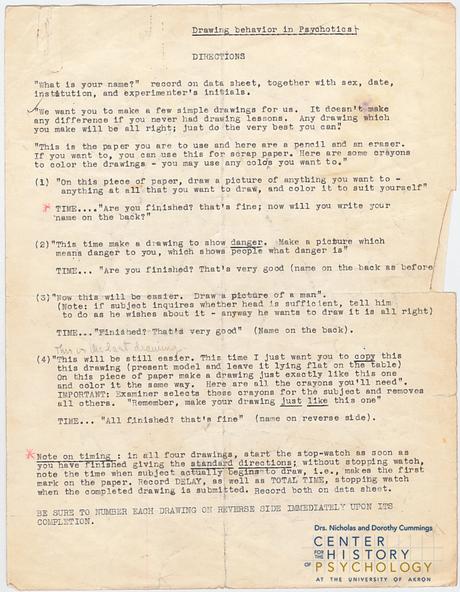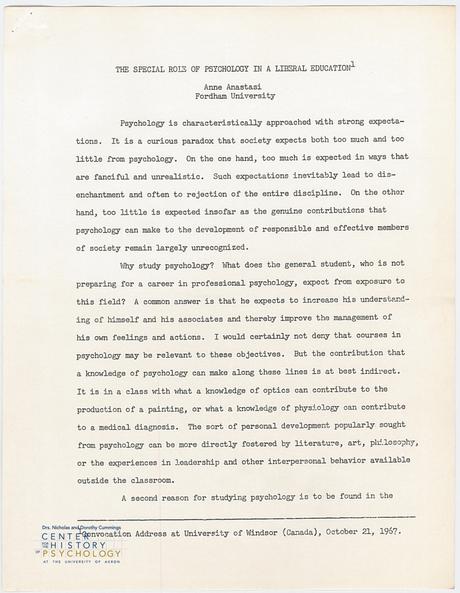contributed by Lizette Royer Barton.
In case you haven’t been following along, we’ve been been highlighting the first five women presidents of the American Psychological Association for a series in honor of Women’s History Month. Working in reverse order we’ve blogged about Florence Denmark and Leona Tyler.
Up next: Anne Anastasi.
Anne Anastasi (1908-2001) served as the third woman president of APA in 1972 – a full 50 YEARS after Margaret Floy Washburn, the second woman president of APA, served in 1921.
Anastasi started college at Barnard at 15-years-old. She earned her PhD from Columbia in just two years at 21-years-old. She chaired the psychology department at Queens College CUNY before she was 35 and she was a full professor at Fordham University in 1951 at the age of 43.
Anne Anastasi was a BOSS. As illustrated by this photograph.
 Anne Anastasi, 1967, David P. Campbell Still Images collection
Anne Anastasi, 1967, David P. Campbell Still Images collectionAnastasi is most well known for her work in psychological testing and the psychology of individual differences. The New York Times dubbed her the “Test Guru of Psychology” in her obituary. She wrote THE book on psychological testing, titling it simply Psychological Testing (1954).
The Anne Anastasi papers contain lot about testing and a lot of material from her time in various roles of APA governance. But you guys already know that about her so how about something else?
In 1936 Anastasi started a research project titled, “An Experimental Investigation of Artistic Behavior in the Insane.”
 Anne Anastasi papers, box M4812, folder 3
Anne Anastasi papers, box M4812, folder 3In 1938 she applied for additional grant funding to continue the project. She asked for $3,800. They gave her $1,000 and she made it work.
 Anne Anastasi papers, box M4812, folder 2
Anne Anastasi papers, box M4812, folder 2“Experimental Approaches to the Psychology of Art” included 4 angles from which to gather materials. Let’s take a closer look at angle 4.
The fourth angle was an “experimental investigation of the drawing behavior of insane patients under controlled conditions….” The patients were provided with crayons and paper and asked to draw: (1) a free choice drawing; (2) an abstract subject; (3) a concrete subject; and finally (4) to copy a sample design.
Here are the specific instructions the investigators used.
 Anne Anastasi papers, box M4812, folder 7
Anne Anastasi papers, box M4812, folder 7The abstract subject was danger and the concrete subject was a man.
During the years Anastasi was working on this project alongside fellow psychologist (and husband) John P. Foley, there was a lot of interest in art done by patients with mental illness, specifically those in asylums. There was interest in art as a form of therapy and also interest in the public exhibition of art created by patients.
In fact, the Federal Art Project, a division of the the Works Progress Administration, held an exhibition titled, “Art and Psychopathology” in Harlem in 1938. The art exhibited was created by patients at Bellevue Hospital and speakers at the formal opening included staff from Bellevue, the WPA, and the Harlem Community Art Center.
 Anne Anastasi papers, box M4812, folder 7
Anne Anastasi papers, box M4812, folder 7Following the research project, Anastai and Foley eventually wrote a manuscript titled, “Artistic Behavior in the Abnormal” complete with numerous full-color examples of patient art. I was so excited to learn that but as I dug through the folder I saw rejection letter after rejection letter. Every publisher said the same thing, the book would simply be “too expensive” with all of the full-color art. Anastasi and Foley published several articles about the research but to the best of my knowledge a large-scale full-color manuscript never came to be. What a bummer.
Anne Anastasi did so much in her long career. I cannot even begin to scratch the surface in a blog. I didn’t even mention her work in vocational guidance and culture-free testing (to which she said there was no such thing!).
Instead I’ll end with this.
In 1967 Anastasi was granted an honorary doctorate from the University of Windsor and at the convocation she presented a paper titled, “The Special Role of Psychology in a Liberal Education.”
 Anne Anastasi papers, box M4822, folder 12
Anne Anastasi papers, box M4822, folder 12The purpose of the paper, I think, was to convey the importance of the scientific method and how psychology can teach that to a variety of students in a variety of ways. And while I did read the whole paper I just couldn’t get that first paragraph out of my head.
It stuck with me though likely not for the reasons Anne Anastasi may have wanted. In describing the field of psychology she also perfectly describes womanhood. Just sub the word “women” for psychology and you’ll see what I mean.
It is a curious paradox that society expects both too much and too little from psychology. One one hand, too much is expected in ways that are fanciful and unrealistic….On the other hand, too little is expected insofar as the genuine contributions that psychology can make to the development of responsible and effective members of society remain largely unrecognized.
Happy Women’s History Month, Dr. Anastasi.
 Anne Anastasi, 1992. Donald Dewsbury Still Images collection, V118, folder 3
Anne Anastasi, 1992. Donald Dewsbury Still Images collection, V118, folder 3
